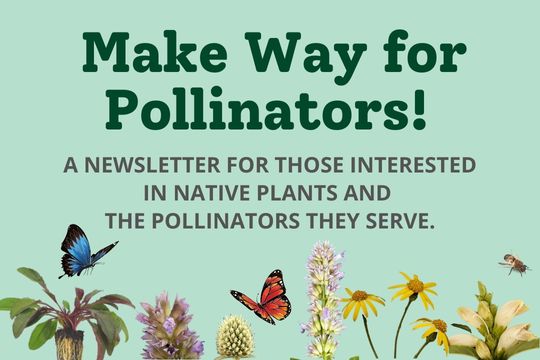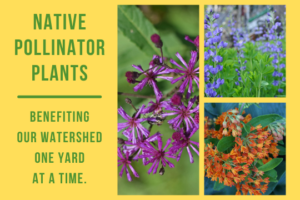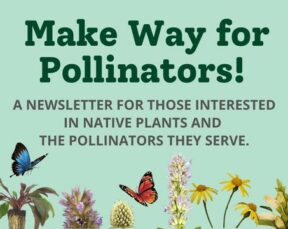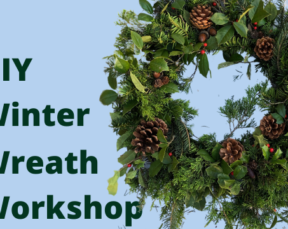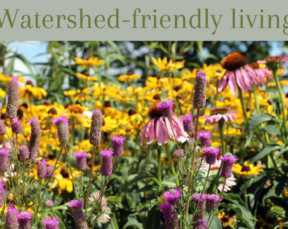Plant Sale Kick Off Webinar
Building on the success of our first two pollinator focused webinars, we will host a third as the official kick off to the plant sale on April 1 – no fooling. If you missed the first two programs on Jersey friendly yards and Pollinator perspectives, email nrago@greatswamp.org to get sent the link to the recordings.
At noon on April 1st, join us on zoom to hear Hazel England, GSWA’s Director of Education, Outreach, and Land Stewardship for an overview of the specific native plants and plant kits available at our 2nd annual online Native Pollinator Plant Sale. She will help you choose from the 28 individual species to create or enhance your own garden in ways that best fit your needs, highlighting the pollinators that visit each flower, and the conditions that best suit the plants. Hazel will also offer some suggestions for 10 things you can do to benefit pollinators in your yard, so it’s not one to miss!! Drilling down into the plants that comprise our 6 different garden kits of 5 species each, you will leave knowing what plants will work for you!
Learn how different plants will help you build your pollinator garden to attract a variety of insects along with the plants you will need to attract pollinators, and how to get started. Discover why this type of garden benefits your yard, your neighborhood, and our shared watershed. We will also walk you through our online storefront and simple ordering process. If you’re considering starting or expanding your native pollinator garden, you’re going to want to check this out! Registration is required and closes @ 10 AM on April 1st. Register HERE > https://bit.ly/3hvS9Zg. You will receive your Zoom link prior to the start of the webinar. The plant sale will officially open at the conclusion of the talk!
Planning Your Native Garden – Where to Start
When thinking about designing your native plant garden, it can sometimes seem a little overwhelming with so many plant options, each seemingly requiring different conditions. (Of course, our plant sale simplifies things with only the best plants!) Follow our tips to plan your desired garden without stress.
Building Your Garden
Start by looking at the conditions of your existing garden or area where the garden will be sited. Whether it is dry, wet, sunny, or shady will determine what species you should select to plant. Our individual plant catalog contains 28 species that fit almost every type of garden, and all are listed with their growing preferences for sun and moisture. Once your garden conditions are known, you can start to pick out species that will thrive in that environment. Preview the GSWA Native Plant Catalog.
If your garden is shady and dry, with well-draining soils that are typically dry when the soil is poked on any given day, native perennials such as wreath goldenrod, or blue wood aster will perform well, as will Christmas fern. Shady conditions are less than 4 hours of direct sun per day- perhaps on the shady side of the house or under taller trees. On the other hand, for sunny and moist gardens, plants such as foxglove beardtongue, culvers root, and swamp milkweed will thrive. Full sun conditions are considered as 6 hours or more of direct sun per day, and often include southerly or westerly exposures. Keep in mind that these are plants native to NJ so given the proper conditions, the plants will need very little maintenance once established.
Flower bloom time is also an important aspect to consider while planning your garden. In the well-planned garden, flower bloom times are staggered to provide nectar to pollinators throughout the growing season. Early bloomers, like columbine and foamflower, sustain early flying pollinators while late bloomers such as seaside goldenrod and blue wood aster provide important nectar source for bees and other pollinators preparing for winter. Check out our Garden Resources Page and pledge to NOT plant Invasive Species and replace them where you can! Use the chart of growing conditions for individual species and makes planning easy. Download the Individual Plant Conditions Table to help in your selection.
When picking your plants, keep in mind that native species provide much more than just a nectar source. Purple coneflower, for example, provides pollen and nectar for pollinators throughout the summer and early fall but also serves as a seed source to birds such as goldfinches during the cold winter months. Other plants, like golden ragwort, serve as an early pollinator nectar source while the rest of the year provides a low growing, weed suppressing ground cover. Year-round ground cover is important in providing habitat for wildlife while also saving maintenance by shading out weeds that may invade over time. Christmas Fern or Pennsylvania Sedge also performs well in this role. Many of the species we will stock additionally provide vital larval food for the young of adult insect pollinators.
Garden Types
You can select single species or our preselected kits to fit your personal garden vision. Our six kits cover three main garden conditions. Sunny moist, Shady, and sunny wet conditions – ideal for wet spots or for creating a rain garden and an expansion kit that allow you to add on for more diversity. Individual species sold can be used to build all kinds of gardens, or to augment existing plantings.
If you are considering removing the grassy strip between the street and sidewalk – often known as a hell strip – for the difficulty of making anything grow well, then you need to consider plants that thrive in the typically very dry, sunny, and overall harsh conditions found here. These strip gardens must often tolerate compaction, drought, full sun, salt, and even dog pee! Species that may thrive here include butterfly weed, seaside goldenrod, blazing star, columbine, and purple coneflower. Hell strip gardens are a great way to pack in natives in an otherwise unused plot of land and show the neighborhood you care!
Our native, deep-rooted plugs will be as happy planted in blocks, clumps, or random drifts to create a bed, and provide instant diversity. If you know you want to benefit pollinators, but aren’t sure what your design aesthetic will be, our helpful resources page has lots of advice, suggestions, and dreamy garden designs to pique your interest and help give your ideas. Try Kate Brandes book ‘Native Plants for the Small Yard: Easy, Beautiful Home Gardens that Support Local Ecology’ or one of our other helpful resources at the Plant Sale Resources Page on our website.
If you are not a fan of the “wild” garden and prefer a little more formality and structure – we have plants that will perform well in formal gardens too. While the asters, mountain mints, and goldenrods with their many small flowers can give off a “wild” feeling, there are many plants in our catalog that create a more orderly impression. Species such as rattlesnake master, culver’s root, obedient plant, and dense blazing star will all do well in typical area conditions – average to moist, sun to part-sun, and even planted formally in clumps or rows, will still make pollinators and other wildlife happy.
So, sit back, relax, and get ready to welcome in the pollinators with just a little forethought and planning.
For more information, visit our Gardening Resources.
Invasive Species in the Yard. How and Why to Avoid Them!
The typical New Jersey yard contains a mixture of trees, shrubs, perennials, annuals, and grasses. But have you ever inventoried your yard to determine which species are native, and which are introduced? Plants growing in your yard can be ‘alien invaders’ spreading beyond the confines of your yard to the forests and ecosystems beyond. Why does it matter what plants you grow in your yard?
Each distinct ecosystem evolved over millennia with a local suite of species interacting, and with plants that gradually adapted perfectly to local soil, climate, and other abiotic conditions, and with all important competition from other local species and interaction between animals and plants. Area insects have co-evolved to pollinate the various species that are native in this region, and to keep fast-growing and spreading plants in check through nibbling on them – known as plant herbivory. Our New Jersey resident and migratory birds eat these native insects, using their populations to sustain and feed their own young, and disperse plants to new locations by eating their seeds and berries. Herbivorous mammals have adapted to eat area plant species, and the plants fight back by filling their cells with nasty tasting chemicals as the growing season progresses, or growing barbs or spines to deter these herbivores and allow an uneasy truce between plant and nibbler.
This then is the native landscape that since the settlers arrived, new plants and animals have been added to. Some plants arrived inadvertently, hitching a ride on the clothes or possessions of settlers. Some were intentionally brought for food or medicine, such as the ubiquitous garlic mustard, native and eaten widely in Western Europe. Some species arrived in the ballast of ships, or as packing material, (Japanese stilt grass was introduced a century ago, being dumped after being used as packing on fragile deliveries from the far east.) More recently species have been introduced for horticultural or agricultural reasons, such as the Eurasian multiflora rose, introduced as a “living fence” to keep cattle in fields without the need for constructed fences, or English Ivy, used intentionally as an evergreen low maintenance ground cover. Cumulatively, these non-natives, alien, and introduced species we term “Invasives”, and they cause huge problems in the landscape.
Why are Invasive Species Such a Problem


Introduced species have not co-evolved with the herbivores our native plant species endure – giving them a competitive advantage when they grow side by side. Native insects avoid feeding on introduced plants they have not evolved with for thousands of years, freeing the invaders from the herbivory that would hold them in check. Many Immature birds eat and spread berries and seeds of alien species, mistaking the mealy, nutrient poor berries of Japanese barberry or European privet for the fat and sugar rich native dogwoods or holly berries they should be eating. Some introduced species green up earlier (non-native grasses), hold onto their leaves for longer in the fall (Norway maples), or produce such copious seeds that they can swamp the local area flora (Japanese stilt grass, Russian Olive, Japanese Honeysuckle to name just a few.) If left unchecked these invasive species march out of gardens and into nearby forests and meadows, forming dense, stands of uninviting, unpalatable, and unwanted plants and causing headaches for land managers.
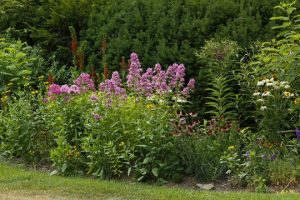

Because these invasive plants are often avoided by local herbivores, they are deemed ideal garden plants in deer heavy neighborhoods. The lack of appeal to local insects to feed on these plants make them desirable for low maintenance plantings. Visit any large garden center and the aisles are filled with plants that provide little for wildlife and spread readily into intact forests and other natural environments.
How to Avoid Growing Invasive Plants
Don’t let your yard be a part of our invasive species problem. Use a field guide or simple identification app such as PictureThis or iNaturalist to identify the shrubs in your yard. On your garden plan, mark those foundation plantings that are invasive shrubs and target these for gradual replacement with pollinator sustaining natives with similar characteristics. Consult local do not plant lists for a list of the established bad guys and be aware of new horticultural introductions – they may yet become invasive.
Please commit to NOT PLANTING invasive plants and remove them wherever you can – Strike Team.
Here are some example common backyard invasive and some native substitutions
Soft Landings - What are They and Why are They Important
After feeding on native tree foliage, many moth and butterfly caterpillars spend their next life cycle stage (pupae) in the leaf litter or in the soil below the tree. Regularly mowed turf grass under trees lacks the necessary habitat for these important insects to complete their life cycles. Frequent mowing also leads to compacted soil. Soft landings are diverse native plantings under keystone trees (or any other appropriate native trees). These plantings provide critical shelter and habitat for one or more life cycle stages of moths, butterflies, and beneficial insects such as bumble bees, fireflies, and beetles. In addition to plants, soft landings also include leaf litter, duff, and plant debris.
Planting intentional soft landings under keystone trees (or any regionally appropriate native tree) builds healthy soil, provides food for songbirds and pollinators, sequesters more carbon than turf grass, and reduces time spent mowing.
Reproduced from PollinatorsNativePlants.com/softlandings.html. Credit: Heather Holm and Neighborhood Greening. Developed in consultation with Desiree Narango, Ph.D.; artwork by Elsa Cousins. Keystone Plants and Soft Landings handout.
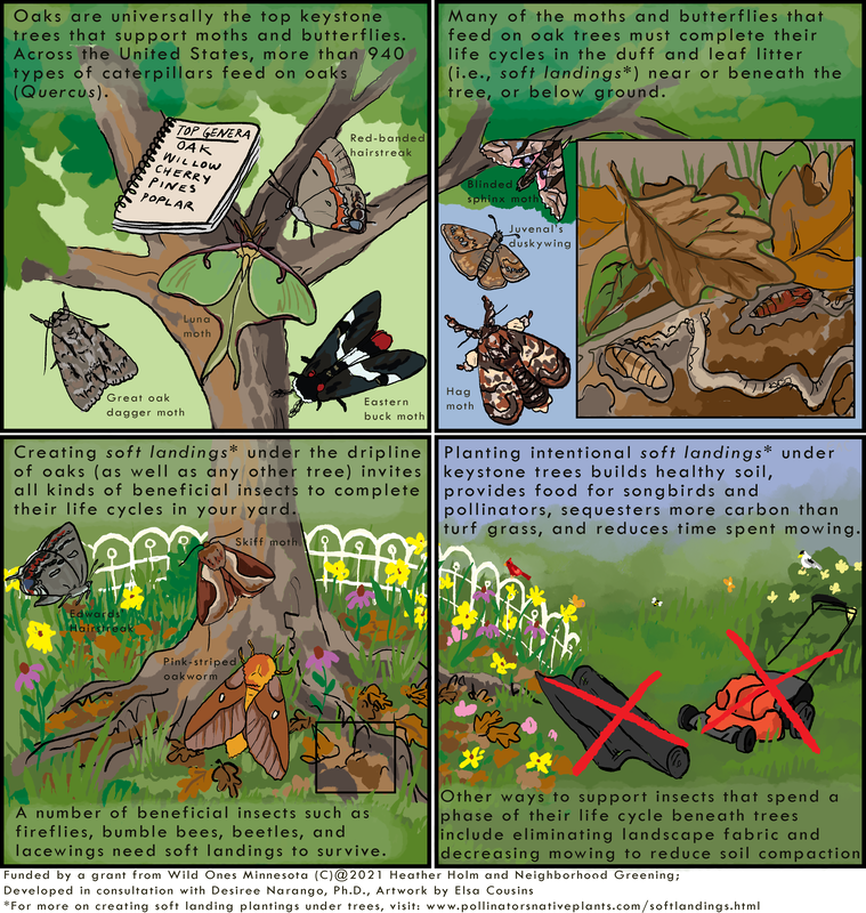

Trees and Shrubs to Support Your Pollinators
It’s more than just the nectar and pollen sources that are important to sustain the populations of pollinators our yards need to be able to contribute to local area biodiversity. The structure of the yard comes from the trees and shrubs that offer overwintering habitat, leaves for insects to munch, places for caterpillars to pupate into butterflies, the leaves that form the nutritional basis of healthy soil, and even holes for solitary pollinators to lay their eggs in. Make sure that your foundation plantings are providing benefit to birds, insects, and other beneficial wildlife. There are many great lists of native shrubs and trees to draw from when considering a new planting, but here is one from Plants for Pollinators partner Summit.
